Green Wednesday: Fragrant Roses and Flamboyant Grebes in Napa Valley
By Bob Niklewicz, UC Master Gardener of Napa County and Kathleen Scavone, Environmental Contributor
Your Support Keeps Us Going
We know there’s a lot of uncertainty right now, and we’re seeing it reflected in our monthly numbers. It’s tempting to pull back — but if you value ad-free, locally focused reporting, now is the time to pitch in.
Your support directly funds weekly offerings like Green Wednesday, so please consider becoming a paid subscriber today. And if you already are — thank you. Every like, comment and share helps us keep going.
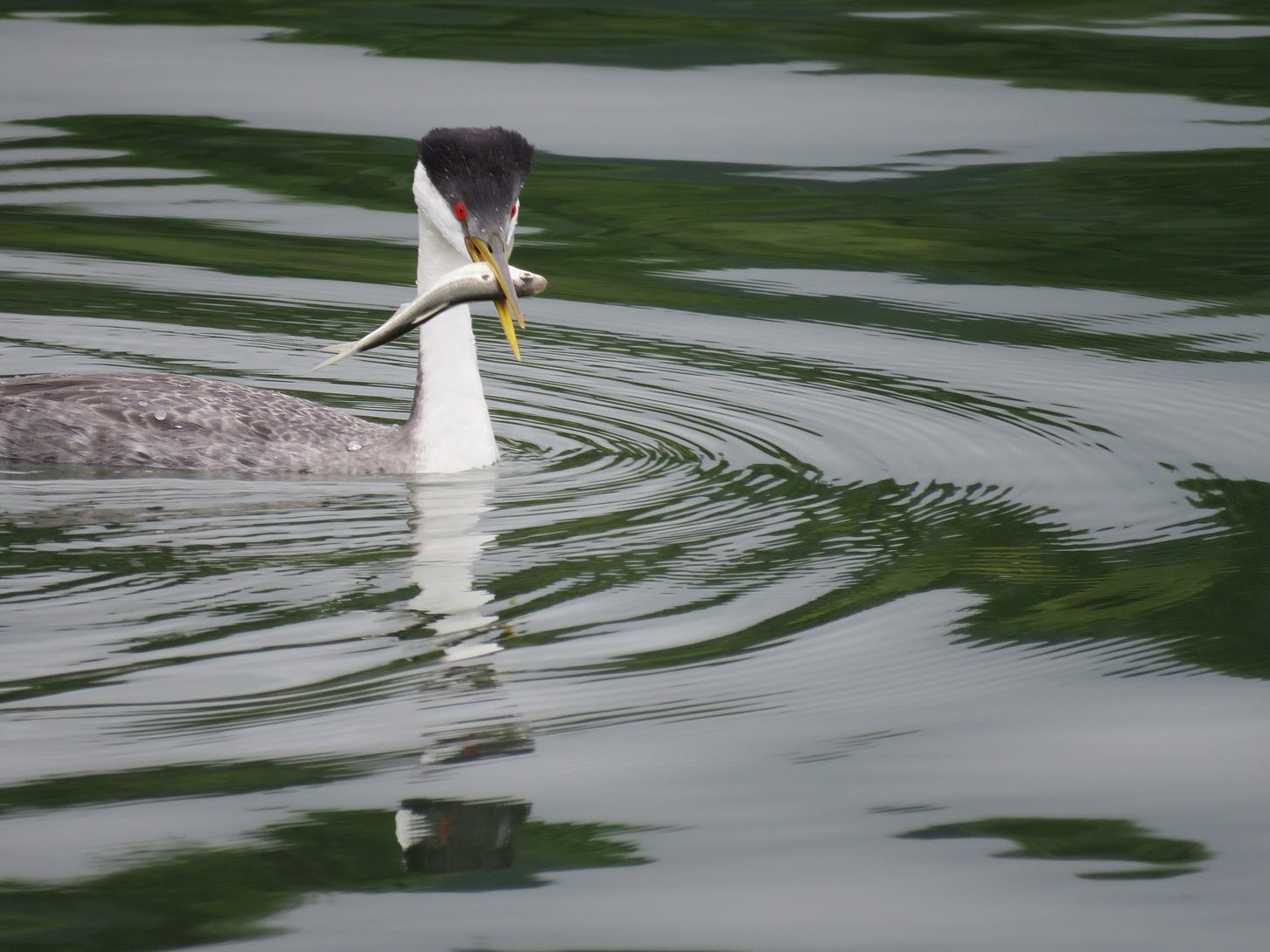
Green Wednesday: Gardening and Ecological Insights
Every Wednesday Napa Valley Features brings you Green Wednesday, featuring articles from environmental voices and the UC Master Gardeners of Napa County. These contributors share research-based horticultural advice and insights on sustainability and climate topics relevant to our region.
Summary of Today’s Stories
"A Reason to Bird Watch: Western and Clark's Grebes" by Kathleen Scavone, Environmental Contributor provides vivid observations and expert insights, celebrating the elegant grebes of Napa County, highlighting their courtship displays and year-round presence in local lakes and wetlands.
"They propel themselves straight up, slender necks outstretched, wings back and literally run across the lake!" — Kathleen Scavone
"Roses Are Fine — Even With No Fragrance" by Bob Niklewicz, UC Master Gardener of Napa County explores the mystery of rose fragrance — why many roses today lack scent, how fragrance is classified and tips for choosing and growing roses with alluring aromas.
"In the world of roses, looks often come at the expense of fragrance." — Bob Niklewicz
A Reason to Bird Watch: Western and Clark's Grebes
By Kathleen Scavone
NAPA VALLEY, Calif. — A morning walk upon the serene shores of Lake Hennessey, Lake Berryessa or the American Canyon wetlands is a delight to the senses. Busy birds of many species abound, but it's the western and Clark's grebes that I'm listening to and watching for on Lake Hennessey. As though reading my mind, a pair of graceful swan-like grebes ethereally float nearby. Their 'creeee' calls echo across the lake, then the birds take turns dipping their bills in the water. Next, they propel themselves straight up, slender necks outstretched, wings back and literally run across the lake! I have just witnessed some of the western and Clark's grebes mating rituals.
Grebes—elegant, swan-like black-and-white water birds—put on an amazing springtime or summer courting dance as they perform what is called 'rushing,' or running across the water! If you are lucky, you may observe other courtship behaviors as they dive for vegetation, then offer the green plants to their prospective mate. Later, the chicks can be seen riding on the parent's backs! Grebe chicks are precocial, meaning that they have eyesight immediately after they hatch and can swim then, too.
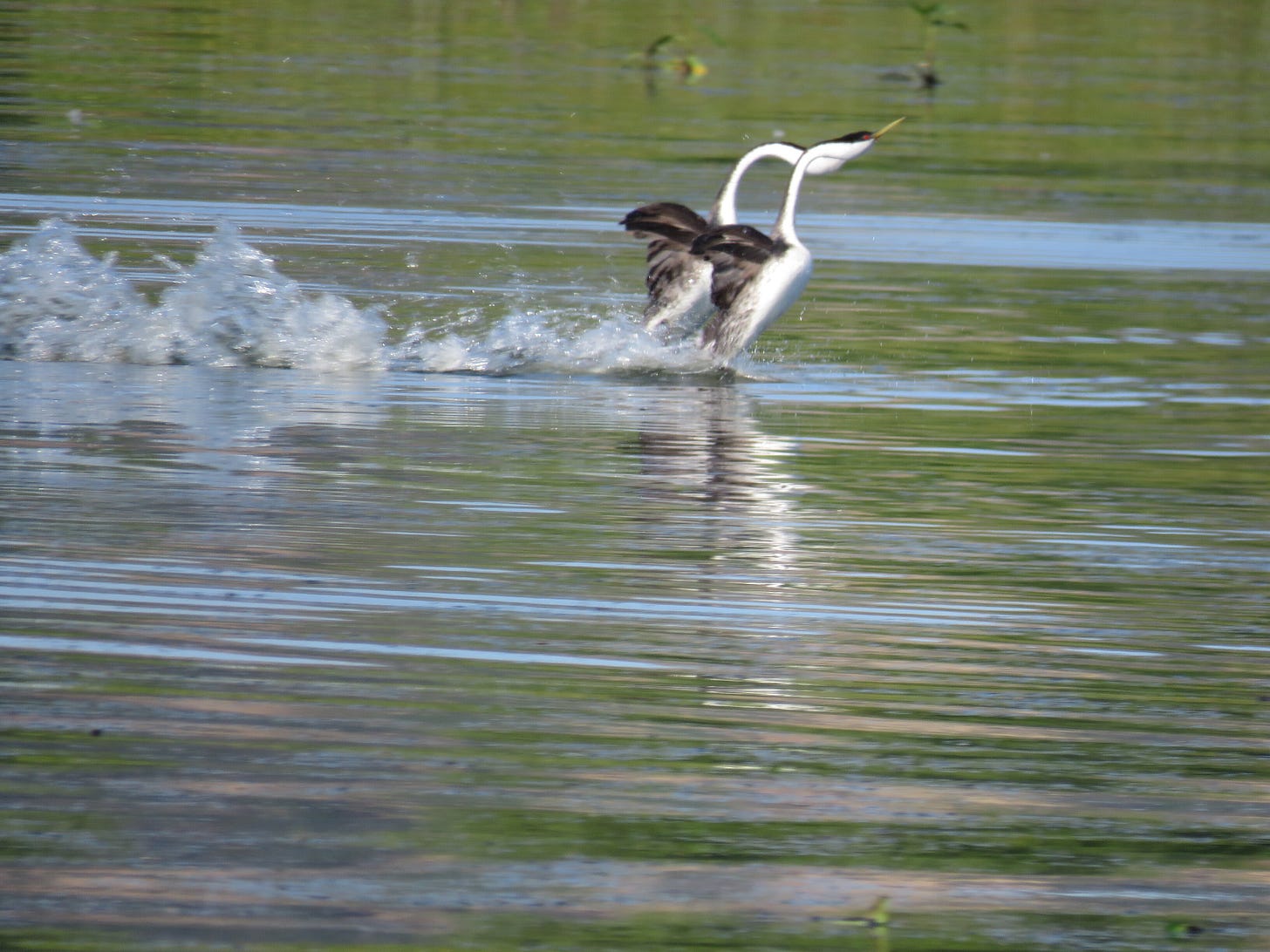
I contacted Floyd Hayes, Ph.D., professor of biology at Pacific Union College in Angwin, since I had some questions regarding grebes and he specializes in the ecology, behavior and biogeography of birds. Additionally, I was familiar with his decade-long grebe studies on Clear Lake in Lake County. He has published seven research papers on the grebes of Clear Lake.
Funding for the grebe project ended in 2019, but he and his colleague Scott Butterfield have written a proposal and have some grant money to resume monitoring grebes on Clear Lake. He was kind enough to respond while in Peru with students.
Hayes explained that grebes in Napa County are present year-round at Lake Hennessey and Lake Berryessa, and he has seen grebe nests on Lake Berryessa in late June and July. Both grebe species breed in mixed colonies of western and Clark's grebes in North America and are known to interbreed. Grebes can be seen in ponds, marshes and lakes, along with estuaries and coastal areas. There are 22 species of grebes found in the world.
Western grebes (Aechmophorus occidentalis) at 22-30 inches appear very similar to Clark's grebes (Aechmophorus clarkii) at 22-29 inches, since they are both black and white. To differentiate the species, western grebes have a black cap that descends below the eye, and their bill is yellow-green. Clark's grebes wear a black cap that rises above their eye, and a yellow-orange bill. Grebes of both species dine on amphibians, crustaceans, insects and fish, most of which they stab with pointy beaks while diving.
Clark's grebes are named for John Henry Clark, who was a naturalist and surveyor in the 19th century. Western grebes are sometimes called swan-necked grebes. It's remarkable to know that when fossils of the western grebe from North America's southwest were studied, they were determined to be from the late Pleistocene epoch. Both grebes’ genus name Aechmophorus hails from the Greek language and translates to 'point of a spear,' referencing the birds' bladelike beak.
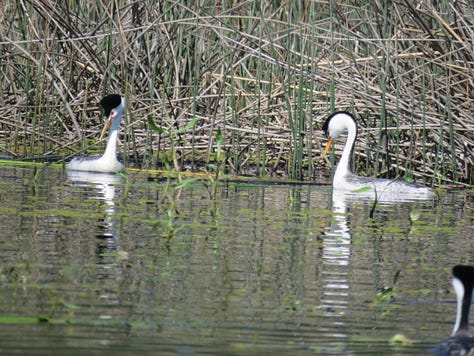
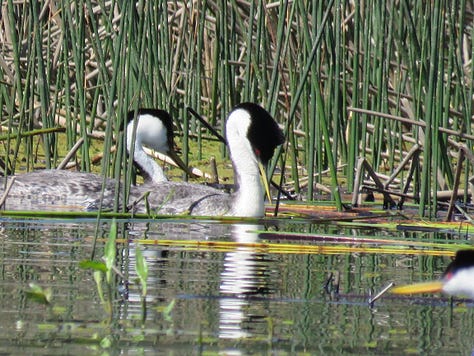
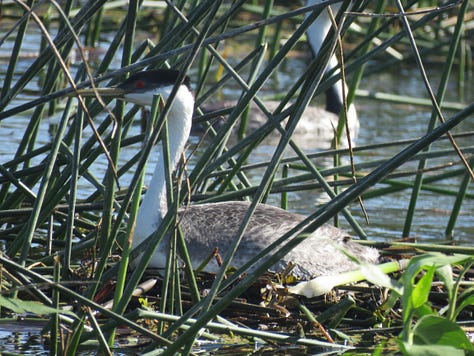
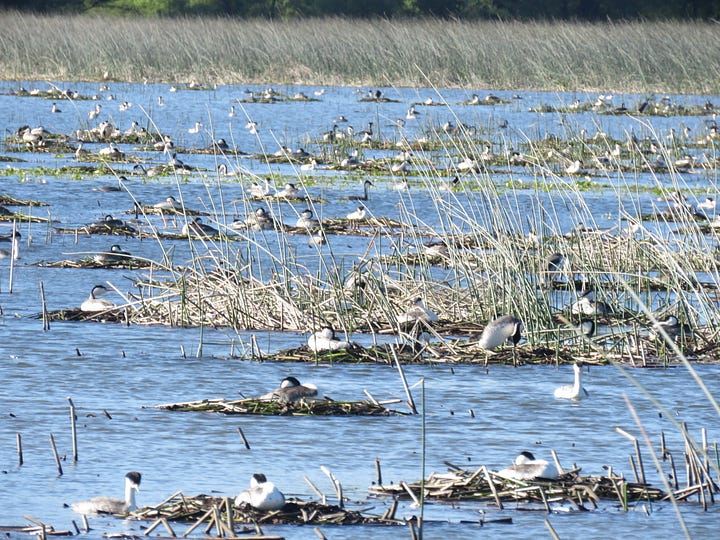

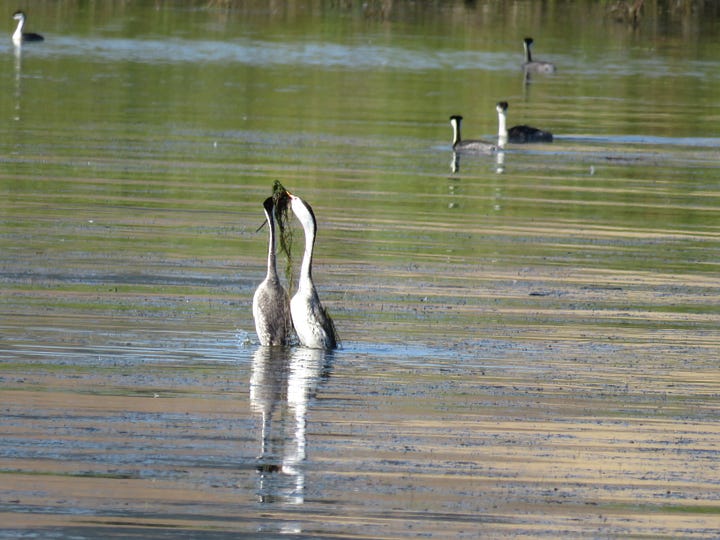

A quick check of the iNaturalist Napa County pages will show an amazing variety of bird species that are found in the local bird counts, and ornithologists explain that grebes are found in Napa County year round. Other bird species you may enjoy viewing include American avocet, Allen's hummingbird, green heron, American wigeon, western bluebird, bald eagle, burrowing owl, American white pelican, western meadowlark and another grebe species—the pied-billed grebe—and more.
Lake County's Clear Lake has been the focus of Hayes' fascinating grebe studies, which I discovered during a memorable boat ride courtesy of Lake County's Redbud Audubon Society on Clear Lake years ago. Audubon leaders cautioned us to steer clear, since both Clark's and western grebes were nesting. Keeping a safe distance ensures that the boat's wake does not disturb their floating nests constructed of reeds and other aquatic vegetation. We observed dozens and dozens of nests, grebes and their eggs. Grebes lay between one and seven eggs annually, with parents of both sexes alternating sitting on the nests until the eggs hatch in a little over three weeks. Hayes' grebes of Clearlake can be viewed on YouTube here.
Here's to blissful bird watching at it's best! Flamboyant grebes are both beautiful and fun to watch. Watch for long-necked water birds along a meandering aquatic ecosystem as they cry out a distinctive call and perform a courtship dance to beat the band!
—
Kathleen Scavone, M.A., retired educator, is a potter, freelance writer and author of “Anderson Marsh State Historic Park: A Walking History, Prehistory, Flora and Fauna Tour of a California State Park,” "People of the Water" and “Native Americans of Lake County.” She loves hiking, travel, photography and creating her single panel cartoon called “Rupert.”
Roses Are Fine — Even With No Fragrance
By Bob Niklewicz, UC Master Gardener of Napa County
NAPA VALLEY, Calif. — For the past three years I have had the pleasure of working in the Fuller Park Rose Garden in Napa and tending the 50 bushes there. Many times, I have been stopped by visitors and asked either, “Which is the best-smelling rose?” or “How come this rose doesn’t smell?”
The look on the face of the visitor who encounters a non-scented rose ranges from dismay to puzzlement or even to fear that they have lost their sense of smell. After reassuring them that they have asked a good question but the answer is not an easy one, I try to explain a bit about rose scent.
First, the preferred term is “fragrance,” and not all roses have it. In fact, the majority of roses do not have a distinct or alluring scent. Those that do have a pleasing smell earn all the oohs and aahs and the satisfied smiles.
There are more than 300 species of roses and thousands of varieties. Most of them do not have a noticeable fragrance.
Modern rose breeders make their profits on roses that look good, have eye-catching colors, are disease-resistant and can last a long time on the stem or in a vase. This is especially true if the breeders sell to grocery stores or to florists. In the world of roses, looks often come at the expense of fragrance.
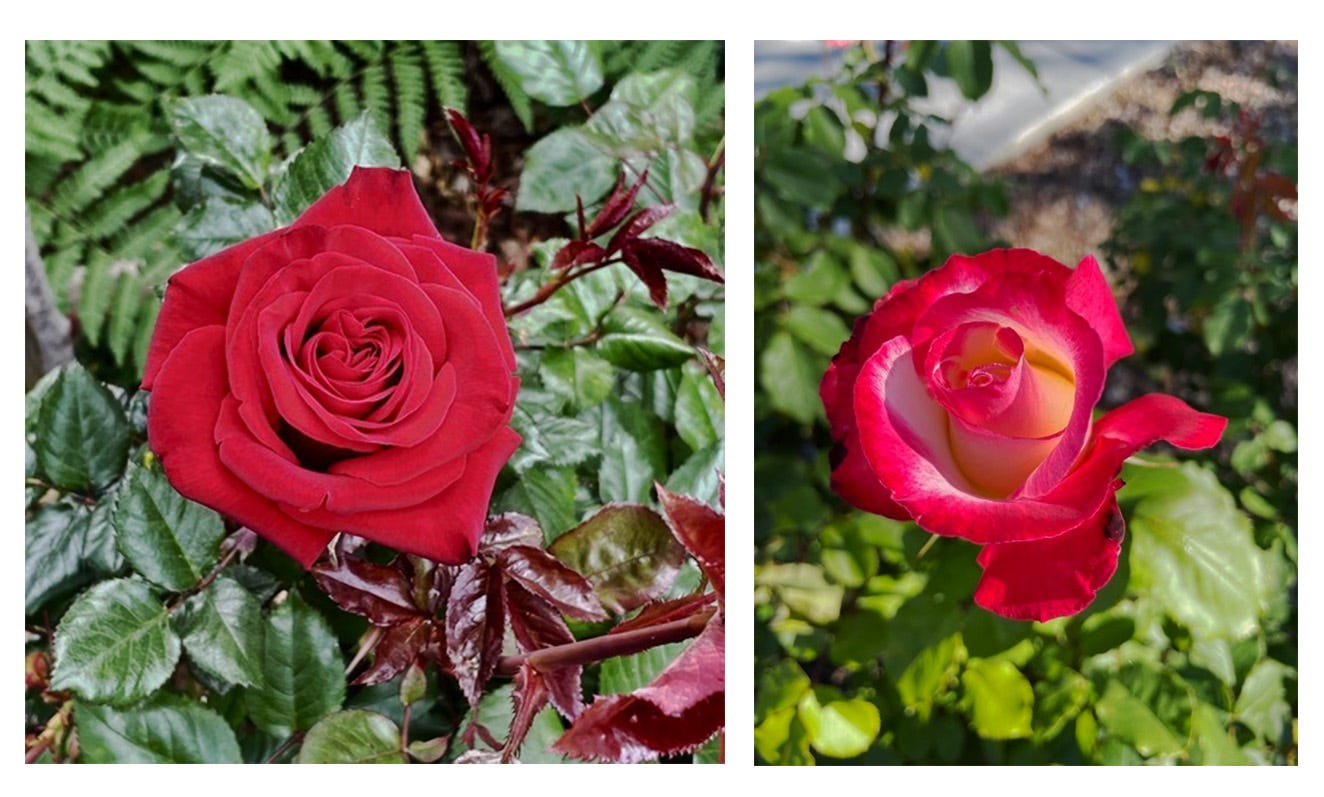
According to the American Rose Society, there are seven basic rose fragrances:
Damask: the classic scent that most people associate with roses
Fruity: suggestive of apples, lemons or berries
Tea: a mild tea-like aroma common in the so-called tea roses
Clove/spice: mostly found in some old-garden roses
Myrrh: a sweet licorice-like scent
Musk: a soft, powdery smell
Green: reminiscent of crushed rose leaves and stems
Soil composition can influence a rose’s fragrance. Planting in loamy, well-draining soil with a pH of 6.0 to 6.5 is a great start. Adding compost and aged manure encourages strong blooms and scent. Do not use fresh manure as it may burn the roots, and that’s hardly the smell you are after.
Roses need at last six hours of sunlight a day to get enough energy to grow. Water deeply two times a week and mulch to conserve soil moisture. Be sure that any excess water drains away. Roses do not like wet feet.
Morning is the best time to smell roses. The early hours are when the blooms’ aromatic oils are at their peak, especially when the buds are one-quarter to two-thirds open. However, the oils are most volatile in warm air, so late morning might be the best time to experience the essence of roses. Remember that one of the main reasons that roses (or any flowers) have a scent is to attract pollinators, not to attract you.
One impediment to smelling roses may be your own equipment. How good is your nose? Are you sensitive to that particular scent? Are you on allergy medications, or have you worked in environments that might have damaged your nasal tissue? If so, you may be out of luck in ever finding that magic fragrance.
If you are nostalgic for the scent of a rose from childhood, consider looking for old-garden roses, also known as antique roses. So-called old-garden roses come from stock available before 1867. But old roses can be a costly habit. A bare-root old-garden rose from a specialized nursery can set you back $100 for a gallon can.
Roses developed after 1867 are considered modern roses and some have strong fragrances. In my yard my favorite is “Mister Lincoln.” In the Fuller Park garden, “Double Delight” and “Firefighter” are particularly fragrant.
Roses with a milder fragrance include “Julia Child,” “Peace,” “Over the Moon” and a couple of others that you’ll find at the Fuller Park Rose Garden. Consult the small signs under each bush.
My own rule of thumb is that older varieties of hybrid tea roses are likely to be fragrant. When you’re at the nursery shopping for that special rose, ask nursery staff or consult the label to know if the variety yields fragrant blooms.
Floribunda roses tend to have mild to no fragrance. Grandiflora roses may or may not be fragrant, so ask nursery staff. Climbing roses may be fragrant especially if they are older varieties. Miniature roses are rarely fragrant.
If you simply must have fragrant roses, ask a nursery person for the names of growers that specialize in fragrant varieties. Otherwise, just enjoy the colors, shape and texture of your rose. Even without a scent, there is enough there to make you go “aah.”
Events
Tree Walk: UC Master Gardeners of Napa County will lead a tree walk through Napa’s Fuller Park on Friday, May 16, from 10 to 11:30 a.m. Fuller Park contains many exotic and native trees that have been planted over the last 120 years. Tour begins at the corner of Oak and Jefferson streets in Napa. The walk is free, but space is limited and registration is required.
Workshop: Join UC Master Gardeners of Napa County for a workshop on “Bringing Natives Home: Designing a Garden With California Native Plants,” on Saturday, May 31, from 10 a.m. to noon at the UC Cooperative Extension, 1710 Soscol Ave., Napa. The Las Flores Native Plant Garden Team will show you how to include and care for native plants in your garden. Register here.
Help Desk: The Master Gardener Help Desk is available to answer your garden questions on Mondays and Fridays from 10 a.m. until 1 p.m. at the University of California Cooperative Extension Office, 1710 Soscol Ave., Suite 4, Napa. Or send your questions to mastergardeners@countyofnapa.org. Include your name, address, phone number and a brief description of the problem.
—
Bob Niklewicz is a UC Master Gardener of Napa County.





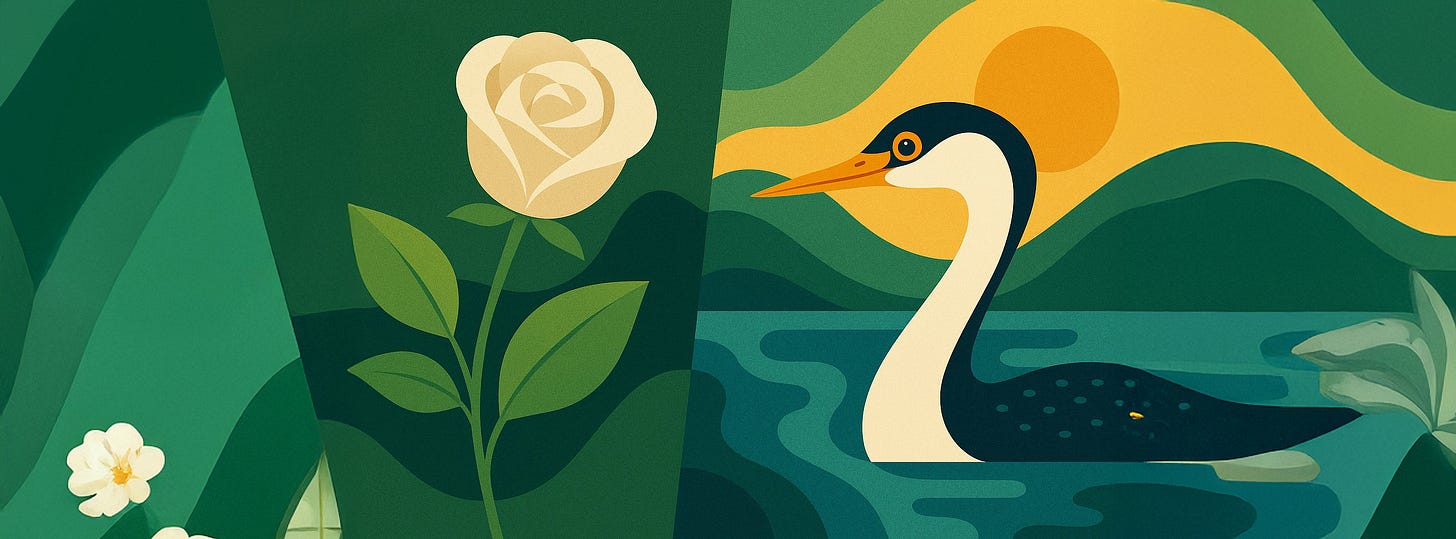
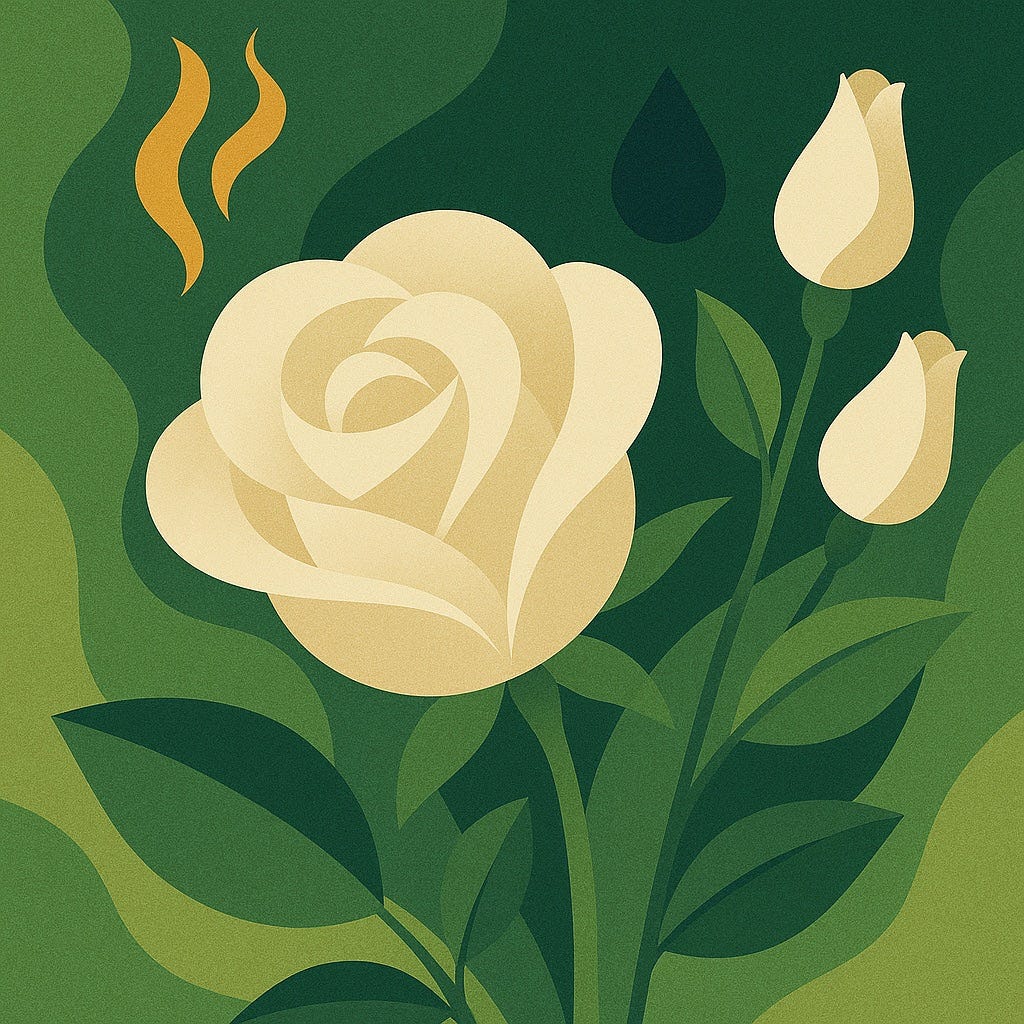
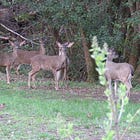



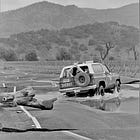
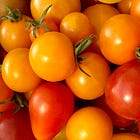
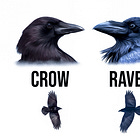

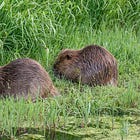

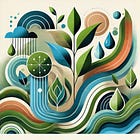




I really appreciated your explanation of the loss of fragrant roses. I didn't know all the aromas that are identified as rose fragrances. To me only the first one you named is the true rose aroma. It laps over into the perfume business as well because the antique flower gardens grown in France that made the unique fragrances that cost so much are gone. Try to find a perfume that truly smells of a rose regardless of how it's labeled or described. There aren't any.
I am so fortunate that my children gifted me a rose bush for Mother's Day about 30 years ago. It has bountiful red blooms, healthy green leaves and the aroma is magnificent. I don't even know its name.
I love the look of the grebes. We have slowly drifted through large flocks (50 - 100) in the middle of Lake Berryessa all summer, every summer, for 20 years. No matter how slow we coast on our patio boat or jet ski through them, their deep dive flushing distance is about 15 feet. Then they surface 20+ feet away. The kids always tried to guess where they would pop up. It's nice to just sit on our stationary boat, surrounded by them, and enjoy their beauty.